Authentic foul (ful) mudammas recipe, made with hearty, creamy fava beans and loaded with flavor from ground cumin, fresh herbs, and a zippy lemon garlic sauce with hot peppers! Don’t worry, the sauce is not spicy, but it adds just the right kick. I use a shortcut in this quick fava beans recipe. Serve it with warm pita bread and sliced veggies. Or turn it into a big vegan feast with sides like tahini, hummus, and roasted cauliflower! Read through for all the tips.
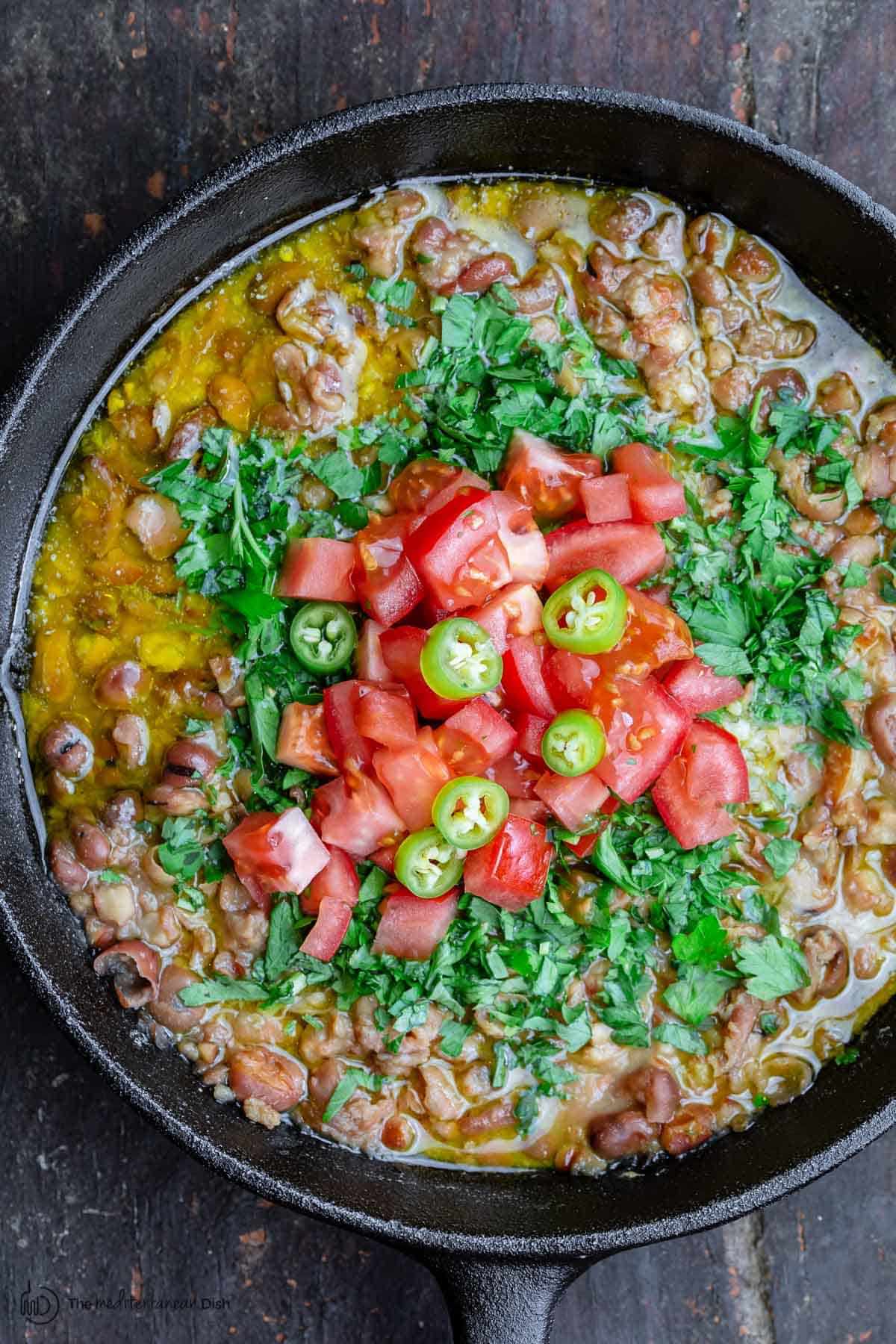
Foul mudammas, pronounced “fool mudammas,” is a popular vegan dish throughout the Middle East and the Levant, but it is actually considered Egypt’s national dish.
Along with falafel and koshari, foul mudammas–also known as ful medames–is the daily grub of the Egyptian people. A humble but tasty vegan meal made of fava beans and served for late breakfast, lunch or even dinner.
Growing up, my family often had little meals of falafel and foul (short for foul mudammas) dinners. It’s about time, this Egyptian girl tells you a bit about a childhood favorite.
What is foul mudammas?
Foul mudammas is basically stewed fava beans (or broad beans), typically seasoned with a little ground cumin and finished with good extra virgin olive oil. Egyptians serve with warm pita bread and jazz it up with lemon juice, fresh veggies and herbs.
There are many ways to dress up this creamy, hearty fava bean porridge or dip. I like my foul mudammas with a spicy kick, so I make a special lemon and garlic sauce with hot chili peppers (although the lemon tames the peppers quite a bit, so it’s really not that spicy but adds a great kick!)
Before we get to this foul mudammas or fava bean recipe, let’s cover a couple of basics…
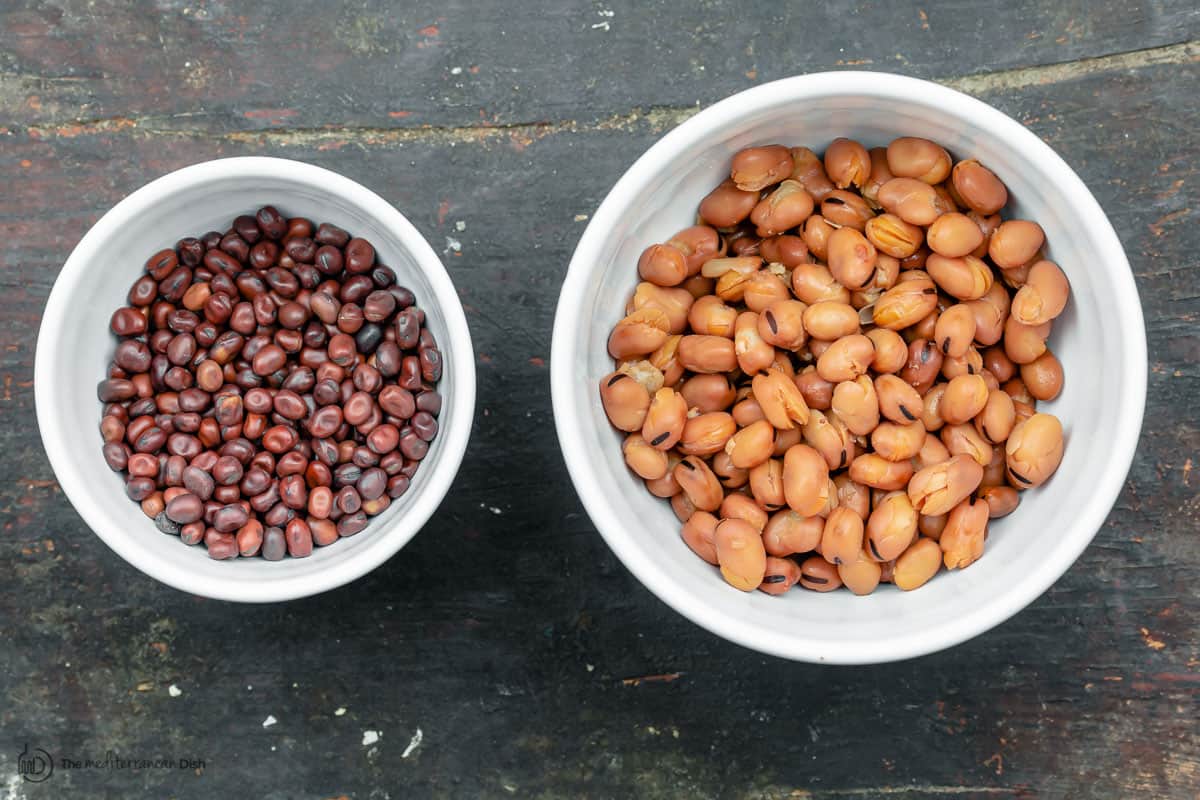
What are fava beans? And where to find them?
Fava beans may not be as familiar to you as black beans or kidney beans, for example. But they are an ancient legume and have been a part of the Middle Eastern kitchen and the Mediterranean diet since the 4th century!
Like many beans and legumes, fava beans are an excellent source of fiber and provide protein and iron.
And as far as texture and flavor, favas are one of the tastiest, meaty bean varieties around–creamy, buttery texture and a lovely, nutty flavor.
Fresh fava beans, also known as broad beans, come in bright bean pods and can be used in many beautiful spring salads and dishes. Sadly, fresh fava beans have a super short season, so you are more likely to find them dry or canned.
To make this foul mudammas recipe, I take a short cut by using canned fava beans. You can find them near other canned beans or the international section at your local grocery store. Otherwise, find canned fava beans via Amazon (affiliate): California Garden Fava Beans and Cortas Fava Beans.
You can also make foul mudammas from scratch, starting with dry fava beans, that’s how my parents used to make it.
Some grocery stores have dry fava beans in the bulk section near things like chickpeas. A couple of options available online: Hunza Fava Beans or Bob’s Redmill Fava Beans, which are a bit larger but can be used in the same way (affiliate links).
Ingredients for this recipe
There are four simple components to this foul mudammas recipe:
1. Fava beans (canned or dry?)
For this recipe, you’ll need to use canned or already cooked fava beans. I am using canned fava beans here for a short cut (2 cans of fava beans or 3 cups).
But, if you want to make foul from scratch, you can start with 1 cup dry fava beans. You’ll need to soak the beans overnight. Drain fully, then cook in plenty of water for about 1 hour or so until tender (see recipe notes.)
2. Seasoning & lemon garlic sauce with chili peppers
The flavor makers in this recipe are decidedly Mediterranean. We start with a pinch of fragrant ground cumin, which adds great depth and aids with digestion.
But the bold flavors in this simple fava bean stew come from a spicy sauce made with crushed garlic, chili peppers and fresh lemon juice.
Don’t worry, this foul mudammas recipe is not necessarily spicy. The lemon juice tames the spicy peppers pretty well, so the sauce actually adds enough of a kick without being overwhelming.
3. Extra virgin olive oil
May seem like a small component of this recipe, but you’ll need a generous drizzle of quality extra virgin olive oil. The EVOO will add flavor and provide that velvety finish to the stewed fava beans. I used Early Harvest Greek extra virgin olive oil
4. Fresh toppings
I love adding a good bunch of fresh parsley and some diced tomatoes on top. Some people like adding chopped onions, but I prefer to serve green onions on the side.
How to make foul mudammas: Step-by-step
Starting with canned or already cooked fava beans, there are three simple steps to make fava beans: warm up the beans and smash them, add flavor, top with fresh veggies.
1. Heat, mash and season fava beans
Remember, you are starting with canned or already cooked fava beans. Drain fava beans and place in a deep skillet or saucepan. Heat over medium-high heat with about 1/2 cup of water. Season with a little kosher salt and ground cumin (cumin adds depth here, but it also helps digestion.) Remove from heat.
Using your potato masher or the back of a fork, mash the beans (you don’t have to mash every single bean, but just do your best to mash them some so they’re nice and soft)
2. Add spicy lemon-garlic sauce and extra virgin olive oil
Using a mortar and pestle, smash garlic and green chili peppers. Add lemon juice and mix.
Tip: the lemon juice tames the chili peppers quite a bit, so this sauce adds a good kick to foul mudammas but it is not overwhelmingly spicy. Just the perfect balance.
Pour the spicy sauce over the fava beans and stir. Add a generous drizzle of extra virgin olive oil (I used Early Harvest Greek extra virgin olive oil)
3. Add fresh toppings
Top the foul mudammas with fresh parsley, diced tomatoes, and a few slices of hot peppers, if you like. Serve with a side of warm pita bread (see more about how to serve it below.)
How to serve it?
You can call it foul for short! Foul mudammas is best served with warm pita bread. You can add sliced tomatoes, cucumbers, fresh green onions and olives to go along.
Foul mudammas is a meal on its own, so you certainly don’t need to add much else. But, you can turn it into a big Middle Eastern vegan feast by adding falafel and sides like tahini sauce (which you can easily drizzle on top); hummus; or baba ganoush!
I love making pita sandwiches with foul mudammas and slices of roasted eggplant or cauliflower.
Leftovers
You can refrigerate foul mudammas (that’s been seasoned and jazzed up with fresh toppings) in a tight-lid glass container for about 2 days (maybe 3 at most). Bring to room temperature and enjoy with pita bread.
If you have cooked fava beans that are plain, those can last in the fridge a couple more days. Be sure the fava beans are fully cooled before storing in the fridge.
For all recipes, visit us here. And be sure to view our collection of Mediterranean diet recipes.
NEVER MISS A RECIPE! JOIN MY FREE E-MAIL LIST HERE.
SHOP OUR ONLINE STORE FOR QUALITY OLIVE OILS, ALL-NATURAL SPICES AND MORE.
Foul Mudammas (Egyptian Fava Beans)

Ingredients
- 2 cans plain fava beans, 13 to 15 ounces each can (see notes if using dry fava beans)
- ½ cup water
- Kosher salt
- ½ to 1 tsp ground cumin
- 1 to 2 hot peppers, chopped (jalapenos will work here)
- 2 garlic cloves, chopped
- 1 large lemon, juice of
- Extra virgin olive oil, Early Harvest
- 1 cup chopped parsley
- 1 tomato, diced
To Serve:
- Warm pita bread
- Sliced tomatoes
- Sliced cucumbers
- Green onions
- Olives
Instructions
- In a cast iron skillet or saucepan, add the fava beans and ½ cup water. Warm over medium-high heat. Season with kosher salt and cumin. Use a potato masher or fork to mash the fava beans.
- In a morter and pestle, add the hot peppers and garlic. Smash. Add in juice of one lemon and stir to combine.
- Pour the garlic and hot pepper sauce over the fava beans. Add a generous drizzle of extra virgin olive oil. Top with chopped parsley, diced tomatoes, and a few slices of hot peppers, if you like.
- Serve with pita bread, sliced veggies and olives.
Video
Notes
- To make Foul Mudammas from dry fava beans: Start with 1 cup of dry fava beans. Soak in plenty of water over night (beans will expand in size.) Drain and discard soaking water. If you like, peel the beans and discard the hard skin. Place beans in a large pot or saucepan, and add plenty of water (about 5 cups or so.) Bring them to a boil over medium-high heat, then cover part-way and let simmer for about 1 hour. Drain and discard water. Proceed with foul muddamas recipe above.
- Where to find fava beans? Fava beans are available in many grocery stores near other canned beans or particularly in the international section. You may also find dry fava beans in the bulk section near chickpeas. Otherwise, find canned fava beans via Amazon (affiliate): California Garden Fava Beans and Cortas Fava Beans. For dry fava beans: Hunza Fava Beans or Bob's Redmill Fava Beans, which are a bit larger but can be used in the same way (affiliate links).
- Visit Our Online Shop to browse our all-natural and organic spices, including cumin, and quality extra virgin olive oils including Greek Early Harvest EVOO!

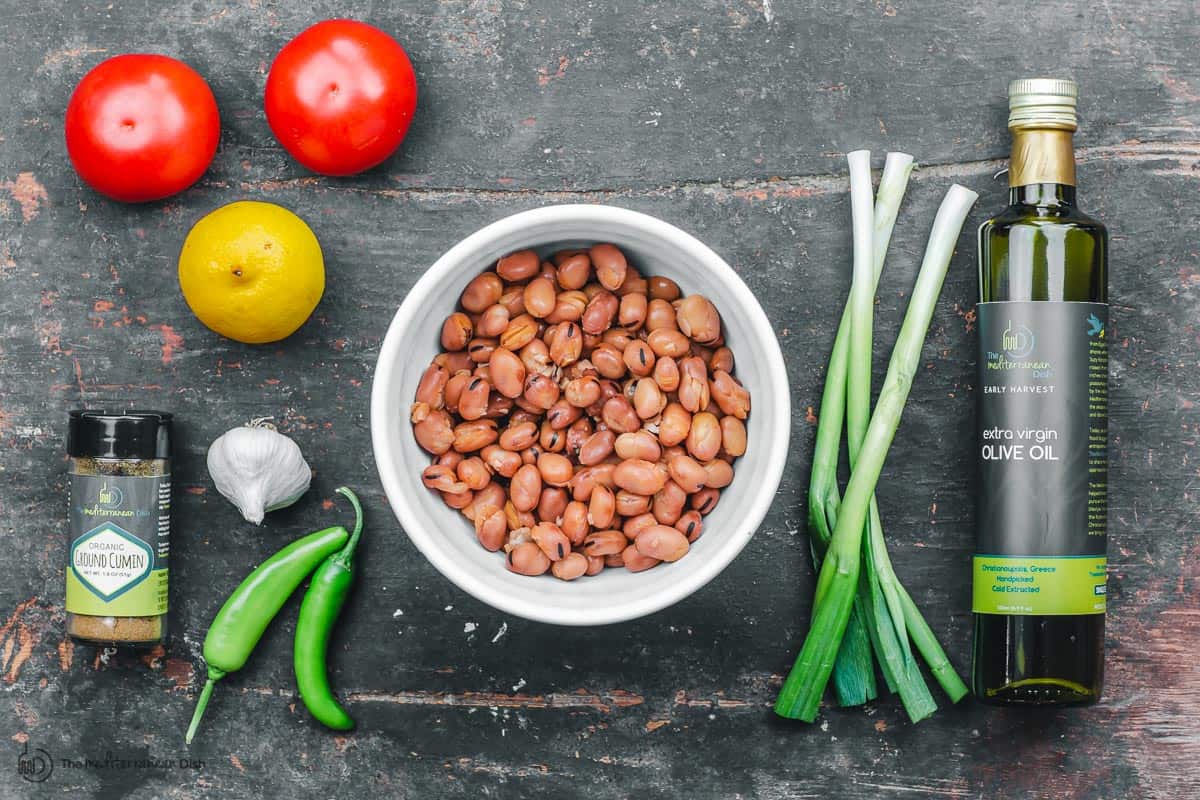
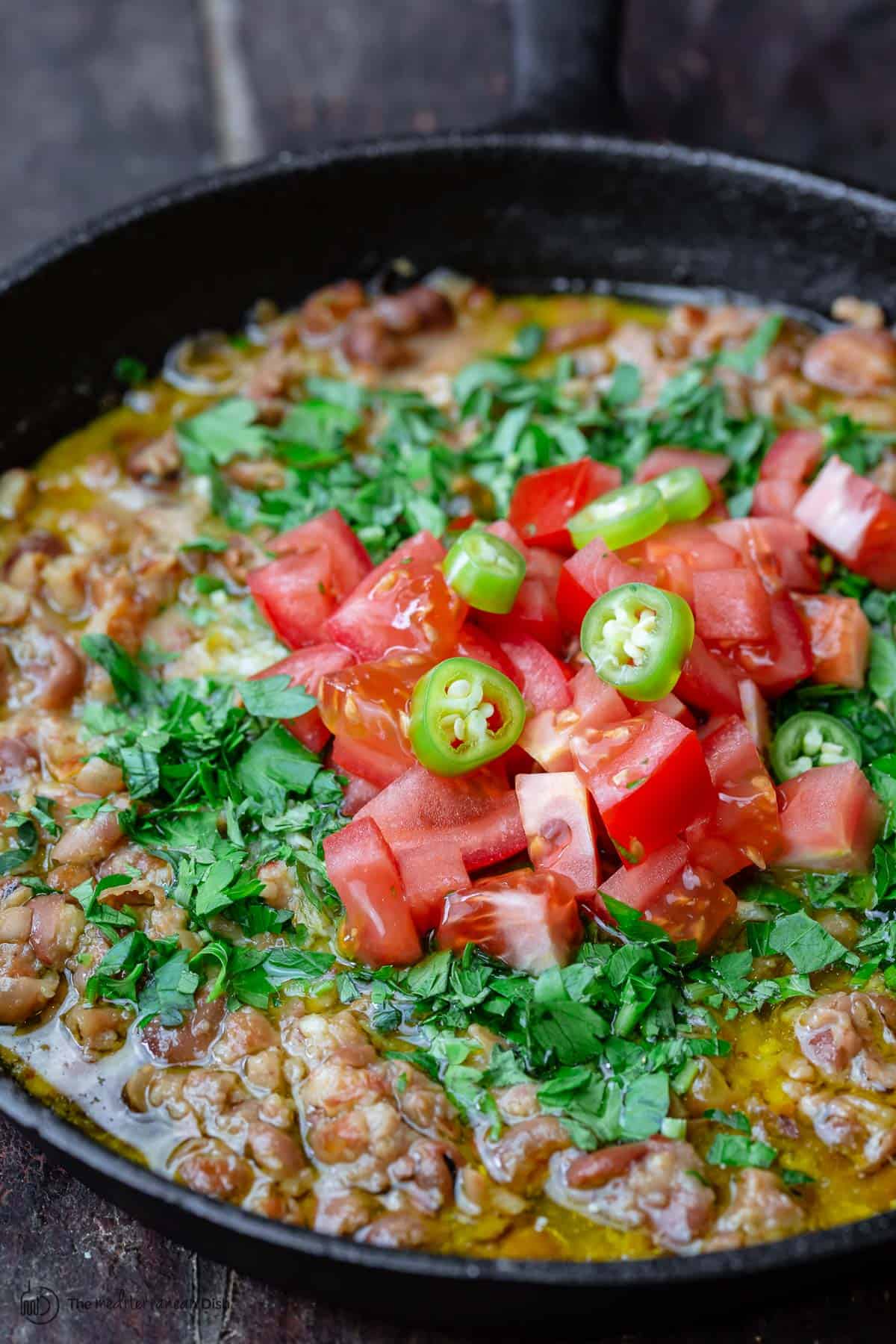
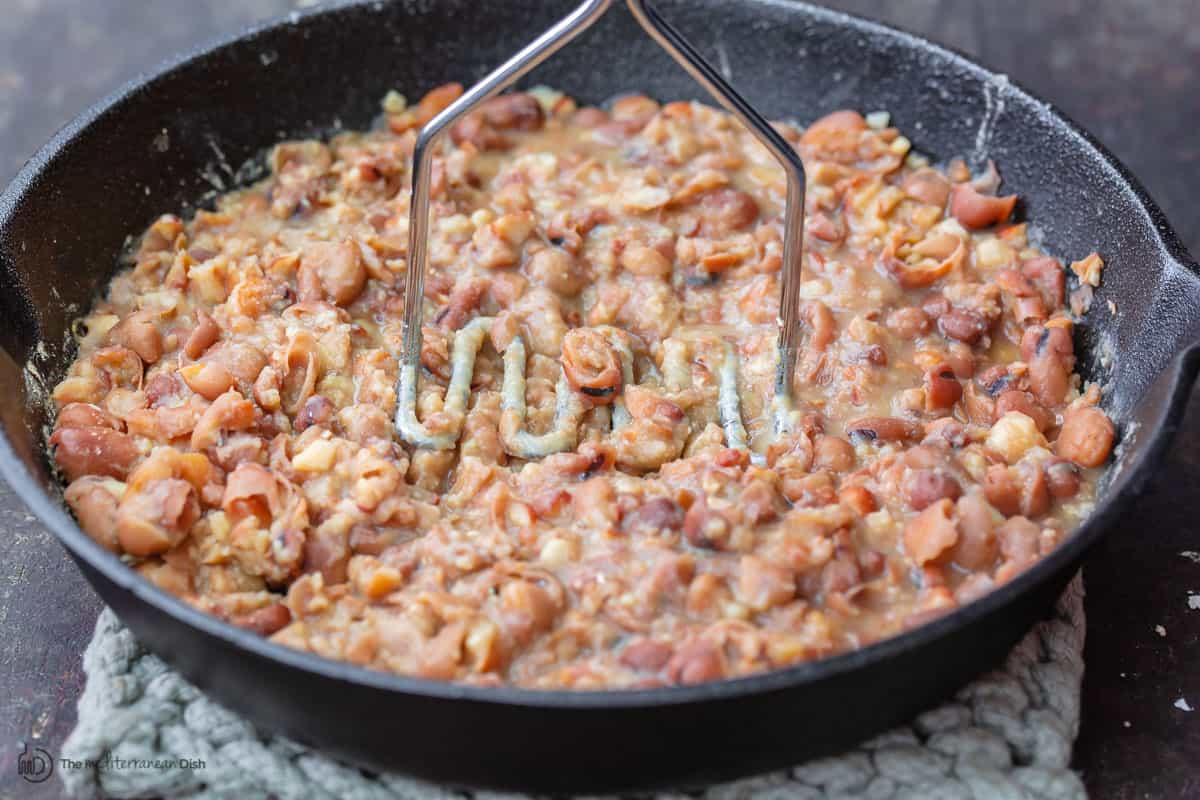
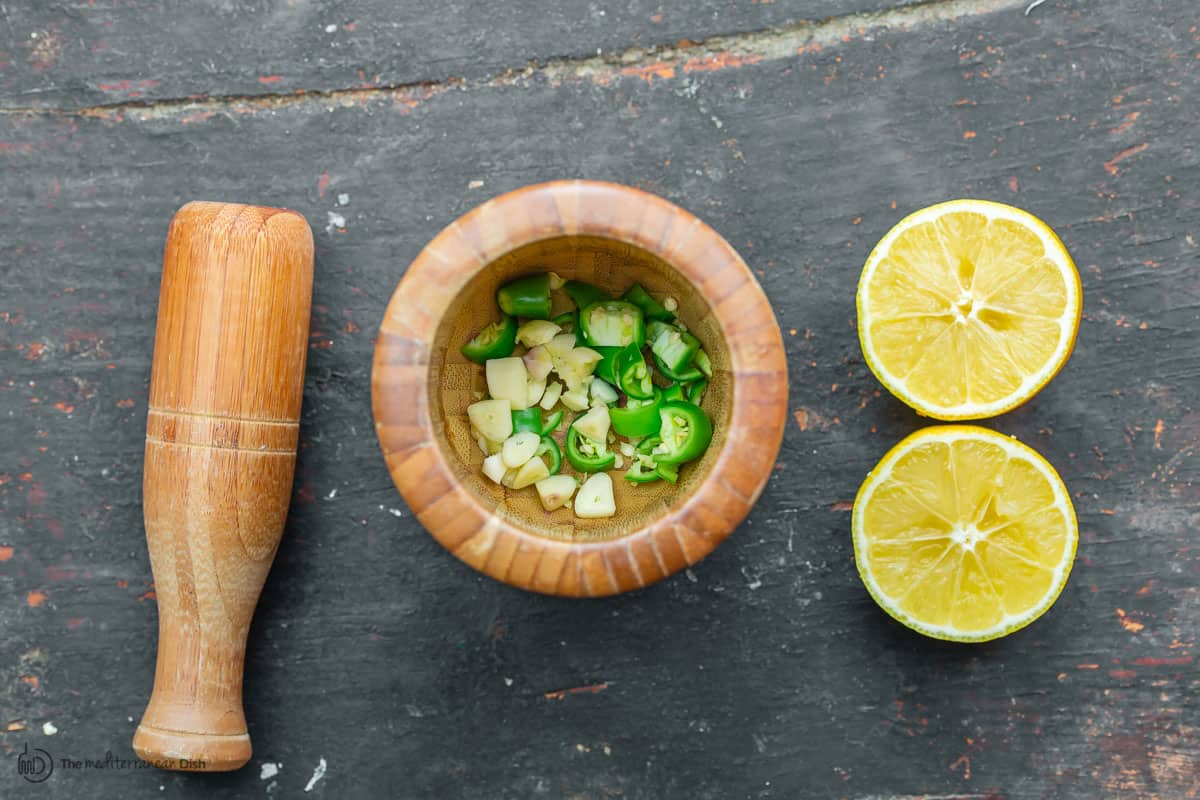
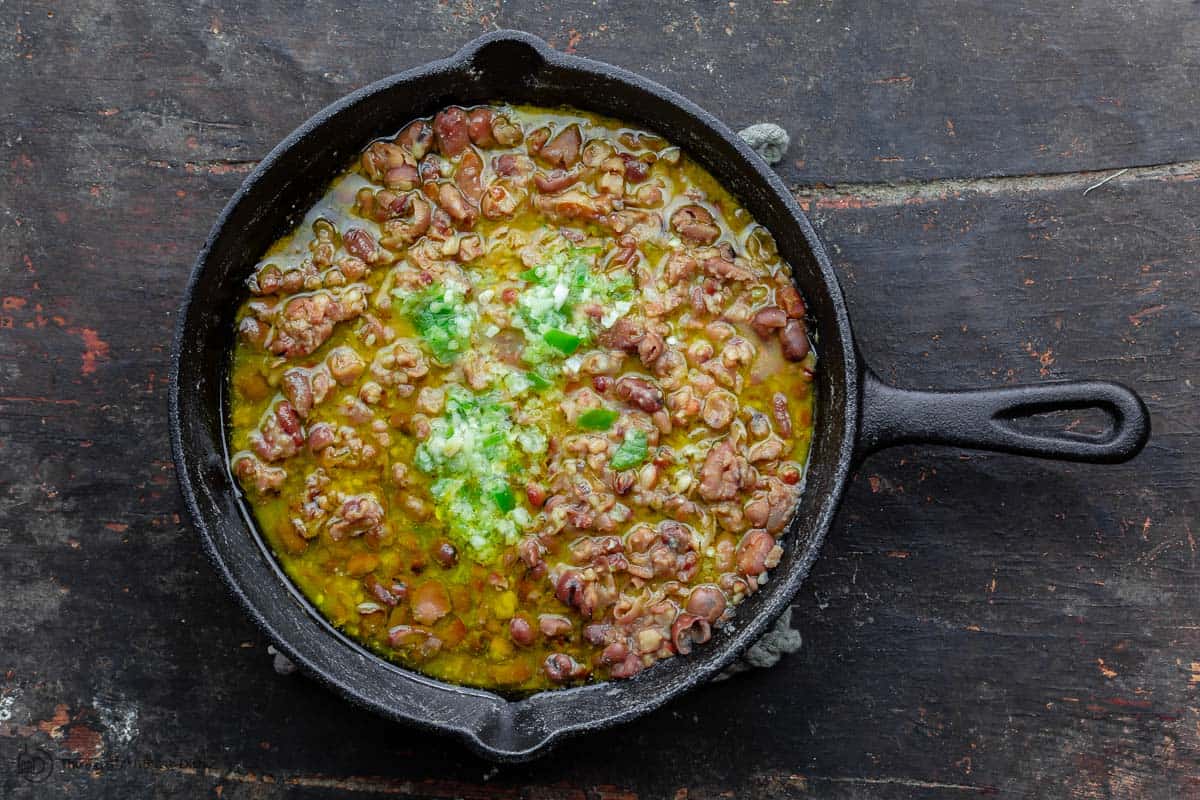
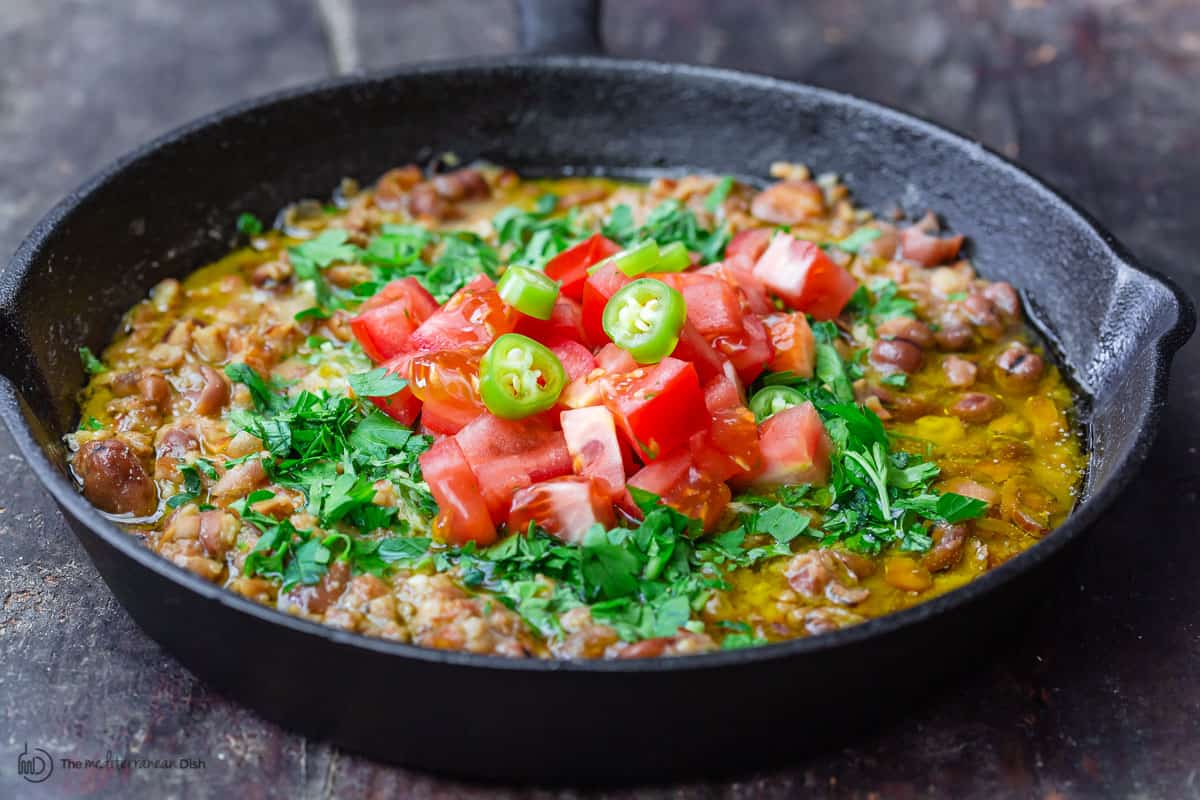

This is *very* good. Served it with 1/2 inch pieces of French bread… so good. I’m thinking about trying it with lime juice instead of lemon next time, it would go well with the cumin and jalapeños.
So glad you enjoyed it, Lisa!
I’d be a fool not to enjoy this. Just what I needed on a cold fall night.
Yes! The perfect comfort food!
This is a snap to make. While it seems to be presented here as a dip or a spread (of sorts) I made it planning to have it with/over basmati rice pilaf (my own recipe with sauteed onions, garlic, and ground pinenuts cooked in) and a vegetable side. It was moist enough to do so. In fact, It was a little juicy, thought that might have been because the canned fava beans were packed in a bit of a sauce. (They were cans left to me when my pandemic boomerang Egyptian-American daughter went back out into the world on her own.) It was a delicious combination.
Due to my plans to serve the ful on rice for dinner, when it came time to add the parsley and tomatoes I allowed the dish to keep simmering for about to 10 minutes. More accurately a left the medium burner on low and allowed the dish to come up to simmering and then turned it off. This brought the final 2 ingredients to a perfect semi-cooked level that allowed for the fresh taste to be maintained at the same time.
Thanks for sharing, Rowen!
Have made this for over a year, when I’m eating healthy and have one of those days, where I wake up super hungry and a lighter breakfast won’t cut it! This is super tasty, filling and feel good breakfast! I have a slice of toast, topped with this, a little cheese, and a poached egg! Keeps me full most of the day. So versatile too. I’ve tried it with pinto beans and kidney beans. Absolutely delicious. Thank you for sharing ❤️
Love it . I tried first time in Dubaj and love the taste ❣️
Thanks, Kasia!
These are similar to my moms recipies
Awww! That is so sweet to hear, Edward!
I have to say, this recipe even impressed my Arabic in-laws when they came to stay. I love this recipe and make it once a week now.
Yesss! I love hearing that. Thanks so much, Christina!
Can I use frozen broad beans instead of canned or dry beans?
Suzy, thank you. how do you make foul Eskandrani. The hot spicy Alexandriam version. Would love to know.
This is absolute perfection. Thank you! My husband is Sudanese and he loved it. Said it was very tasty—and it was! So easy and nutritious too. We’re having the left-overs for breakfast. I’m adding it to my staple dishes.
Yay! Thanks, Philip!
This recipe was so flavorful! It was much better even than the foul I ate at hotel breakfasts in Egypt while traveling. I used the only fave brand I could find— enormous dry beans. They mashed up just fine and even my small children enjoyed it. The jalapeño added the right flavors. This recipe is a keeper. Thank you!
Love to hear it! Thanks, Meara!
My family has two versions of how we make foul, the warm way like this version (we also stew it with tomatoes sometimes), and the cold version.
For the cold one, we add mint and oregano with lemon and olive oil to the cooked beans (for both ways we always use the small ones). Then add diced tomatoes, and thinly sliced radish and red onions. Sometimes a little crushed garlic to rub the bowl, and Za’tarr or sumac as well…and even parsley.
My husband likes it with the Za’tarr—he calls it ‘the bread spice’ 🙂
Thanks for sharing, Liz!
Thanks heaps 😊
This recipe is so easy, but also delicious, flavorful, nutritious, and satisfying! I wondered why the garlic wasn’t sauteed in olive oil first, then the beans cooked in the same pan. Once I tried it, I understood – the flavor of the raw garlic, fresh lemon, and olive oil on top rather than mixed in is so wonderful! I happened to find corona beans and used them the first time I made it, and it was tasty. I made it with canned fava beans the second time, and I think the color and flavor was nicer. I would also like to try it with pinto beans since those are easiest to find, although I completely understand that is not traditional! Thank you for this recipe.
Thank you so much for the wonderful feedback!
As an Egyptian, I’m surprised tat you mash the beans before you serve them. I have never seen this done. If we want them mashed, we just use our forks and do that in our bowls.
Other beans cannot be substituted for fava beans, The taste is so unique that no other legume comes even close.
As for rinsing the canned version. I have also never seen this done. It must be an American thing.
Interesting. Thanks for sharing. This is the way my family prepared it growing up. I’m sure you’re aware that each family kitchen puts their own twist on a beloved recipe :).
I am not able to find Fava Beans anywhere in my area. I read on-line that you can substiitute Lima Beans or Edamame?
Since I have never eaten a fava bean, I have no idea what they taste like.
What is a good substitute in your opinion
Hello! I’ve found pinto beans to work well with this recipe if you can’t find fava beans.